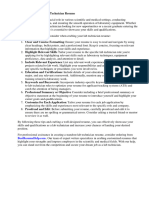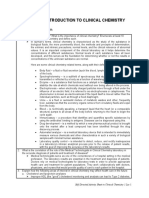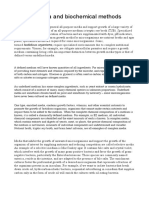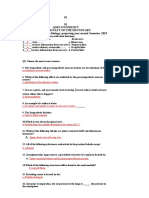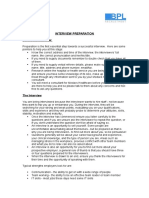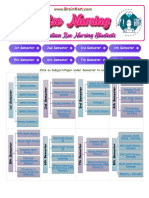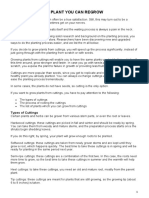MTMLT Content Outline
MTMLT Content Outline
Uploaded by
georgescribd33Copyright:
Available Formats
MTMLT Content Outline
MTMLT Content Outline
Uploaded by
georgescribd33Copyright
Available Formats
Share this document
Did you find this document useful?
Is this content inappropriate?
Copyright:
Available Formats
MTMLT Content Outline
MTMLT Content Outline
Uploaded by
georgescribd33Copyright:
Available Formats
Content Outline for Medical Technologist and Medical Laboratory Technician Certification Examinations
GENERAL LABORATORY: (MT=12% / MLT=13%) A. Laboratory quality 1. Perform quality control necessary in the clinical laboratory and for point-of-care testing, and know related terminology: linearity accuracy precision reliability delta o.d. coefficient of variation skewness mean value standard deviation shift, trend
confidence limit normal distribution standard deviation index (SDI) Levey-Jennings charts
2. Perform laboratory and point-of-care proficiency testing 3. Review and evaluate results of proficiency testing with all laboratory personnel and implement appropriate corrective action 4. Understand the differences between accuracy and precision 5. Review all kit/procedure package inserts to assure that accurate and up-to-date testing procedures are being executed 6. Employ quality improvement (TQM, CQI, PIC) B. Laboratory laws and regulations 1. Observe OSHA regulations 2. Observe CLIA regulations 3. Observe HIPAA regulations C. Laboratory safety 1. Employ universal (standard) precautions 2. Employ equipment safety to include sharps for needle disposal 3. Employ materials safety (and MSDS sheets) 4. Employ hazardous chemical safety 5. Employ proper infection control through the use of hand washing, gloves, and alcohol gel D. Laboratory instrumentation, maintenance, and principles of operation 1. Use manual instrumentation a. Use glassware and pipettes b. Clean and maintain instruments c. Calibrate instruments knowing the difference between testing d. technologies requiring calibration and those requiring only e. quality control checks (non-calibratable, rate reaction tests) 2. Balance centrifuge and know centrifugation durations 3. Assure proper centrifuge setup and operation and RPM/RCF 4. Use automated instrumentation and analyzers E. Laboratory mathematics 1. Know normal solutions, molar solutions, percentage solutions (w/w, w/v, and v/v), calculate equivalent weight and dilutions used most frequently in the clinical laboratory 2. Know designations and abbreviations used for weights and measures F. General microscopy 1. Know types of microscopes 2. Know parts of binocular microscope
3. Use binocular microscope 4. Calibrate ocular micrometer 5. Clean microscope G. Phlebotomy and Specimen Collection 1. Collect and handle blood specimens for analysis 2. Know the differences between serum, plasma, and whole blood 3. Employ safety precautions when collecting blood samples 4. Employ procedures to prevent hemolysis 5. Collect blood in collecting tubes for analysis (clotted blood and anticoagulated blood) 6. Employ proper order of draw when collecting blood in multiple types of vacuum tubes 7. Employ proper anticoagulants for each analysis 8. Know effects of improper anticoagulant use 9. Handle and preserve body fluids for chemical analysis Preserve urine specimens 10. Preserve urine specimens 11. Know procedure for blood culture collection 12. Know the proper labeling of blood tubes including sentinel event with blood bank arm bands 13. Process irretrievable specimens (CSF, tissue, etc.) 14. Perform infant blood collection through heel puncture 15. Perform glucose tolerance test 16. Know length of time for samples to clot H. Patient Identification 1. Match name, MR, DOB, registration number, and other identifiers with tests and orders to confirm positive patient identification 2. Confirm patient identification through all processes (to include STAT, call reports as inpatient and outpatient) I. Waived testing 1. Address waived testing in the clinical laboratory
II. CHEMISTRY (MT=20% / MLT=18%) A. General knowledge 1. Define the following terms and describe how they are used in the clinical chemistry laboratory: spectrophotometry densitometry refractometry electrophoresis turbidimetry nephelometry osmometry mass spectrometry chromatography enzyme linked immunoassay (ELISA) chemiluminescence fluorescence polarization immunoassay (FPIA) 2. Define terms related to principles of instrumentation and describe how they are used in the clinical chemistry laboratory: radiant energy end point reactions kinetic/rate reactions Beer-Lambert Law visual spectrum/wavelength diffraction grating random access
B. Instrumentation: Parts, principles of operation, and maintenance 1. Perform spectrophotometric procedure a. Describe monochromater/diffraction grating b. Differentiate between colorimeter/spectrophotometer 2
c. Describe measurement of wavelengths d. Calibrate spectrophotometer 2. Demonstrate the ability to operate and describe the principles of operation of the following: a. refractometer b. osmometer c. nephelometer d. immunoassay analyzers e. random access analyzers f. blood gas analyzers g. sandwich technique of EIA h. discrete analysis 3. Demonstrate an understanding of the use of Beer-Lambert Law 4. Describe chemistry analyzer maintenance C. Renal Function Tests 1. Perform renal function tests 2. Demonstrate understanding of the following: a. anatomy and physiology of kidneys b. common tests for renal function (non-protein nitrogens) c. clearance tests d. reference ranges e. estimated glomerular filtration rate D. Hepatic Function Tests 1. Perform hepatic function tests 2. Demonstrate understanding of the following: a. anatomy and physiology of the liver b. formation of bilirubin and urobilinogen c. types of bilirubin d. types of jaundice e. common tests for liver function f. describe and differentiate tests that are elevated in liver disease, obstructive jaundice, and hemolytic jaundice E. Carbohydrate Metabolism Tests 1. Define terminology related to carbohydrates and carbohydrate metabolism carbohydrate monosaccharide disaccharide polysaccharide glycogen ketones insulin glycolysis glycogenesis glycogenolysis lipogenesis renal threshold diabetes mellitus A1C hemoglobin
2. Demonstrate understanding of the following: a. classification of carbohydrates b. digestion of carbohydrates c. insulin and carbohydrate metabolism d. types of diabetes e. tests for glucose in blood, urine, and cerebrospinal fluid f. glucose tolerance tests g. A1C hemoglobin 3. Perform and interpret tests for glucose analysis a. Perform tests for all carbohydrates and reducing substances b. Perform testing for glucose on blood, urine, and spinal fluid 4. Perform glucose tolerance test a. Perform oral glucose tolerance test 3
b. Recognize and differentiate normal glucose tolerance, diabetic glucose tolerance, and hypoglycemic (flat) curves 5. Describe the principles of, and perform glycohemoglobin A1C procedure F. Protein Analysis 1. Perform protein analysis 2. Demonstrate understanding of the following: a. protein classification b. synthesis, distribution, catabolism, and excretion of proteins c. function of plasma proteins d. tests measuring total protein, albumin, globulin, and immunoglobulins e. reference limits f. principles of protein electrophoresis g. normal and disease patterns in protein electrophoresis h. interpretation of SPE patterns i. clinical correlations with disease G. Enzymology 1. Demonstrate understanding of the following: a. clinically-significant enzymes CP ALT ALP AST amylase CK GGT LD lipase
2. 3. 4. 5. 6. 7.
b. isoenzymes (CK, ALP, LD) c. measurement of enzyme activity d. cardiac enzymes and related markers (troponin, myoglobin) e. pancreatic enzymes f. enzymes associated with the liver Differentiate enzymes of the pancreas and tests used to determine the activity of these enzymes Describe cardiac enzymes and interpret test results (describe order in which cardiac enzymes rise and return to normal) Describe cardiac markers and their uses Describe enzymes elevated and differentiate liver diseases based on the results Demonstrate knowledge of acid phosphatase and alkaline phosphatase and correlate with disease states Perform cardiac marker tests a. troponin T and I b. cardiac myoglobin c. B natriuretic peptide (BNP) d. C-reactive protein (CRP)
H. Endocrinology 1. Demonstrate understanding of the following: a. endocrine system (glands and hormones) b. function of hormones c. feedback mechanisms d. common tests and reference ranges e. conditions resulting from hypo- and hypersecretion of hormones 2. Perform thyroid function testing (TSH, free T3) 3. Perform 24-hour urine endocrinology tests (T3, 5HIAA) 4. Perform tests for reproductive hormones (FSH, LH, estriol, estradiol, estrogen, testerosterone, 17-ketosteroids) 5. Perform tests for pregnancy hormones (HPL, HCG, prolactin)
I. Lipids 1. Demonstrate understanding of the following a. cholesterol and triglyceride metabolism b. lipoproteins c. desirable limits (Lipid Research Clinic, etc.) d. methodology for measurement of lipids e. diseases associated with hyperlipidemia J. Water and Electrolytes 1. Demonstrate understanding of the following: a. characteristics of electrolytes b. fluid movements and compartments c. electrolytes in body fluids (cations and anions) d. electrolyte balance e. expressing concentration of electrolytes (meq/L) f. reference limits of electrolytes g. methodology for measuring electrolytes h. electrolyte imbalances K. Acid-Base Balance 1. Demonstrate understanding of the following: a. hydrogen ion concentration (pH) b. relationship of pH, bicarbonate, and carbonic acid (Hendersonc. Hasslebach equation) d. regulation of acid-base balance by kidneys and lungs e. acid-base imbalances f. tests for acid-base balance L. Other Chemistry Procedures 1. Demonstrate understanding of the following: a. C-reactive protein b. BNP c. cerebrospinal fluid concentrations d. tumor markers 2. Perform electrophoresis a. Define the general principles of electrophoresis b. Define the principles of protein electrophoresis c. Define the principles of immunoelectrophoresis d. Define the principles of isoenzyme electrophoresis (LDH,CK, e. alkaline phosphatase) f. Define the principles of hemoglobin electrophoresis 3. Perform C-reactive protein tests 4. Perform and interpret test for specific disease states such as the presence of gout a. Perform test for uric acid b. Describe the metabolism of purines in food and the formation of uric acid 5. Demonstrate knowledge of minerals of the body and mineral metabolism 6. Perform therapeutic drug monitoring and define the following terms: a. b. c. d. e. f. a. peak and trough g. antiepilectic drugs and metabolites b. mechanism of action h. cardioactive drugs and metabolites c. steady state kinetics i. antidepressive drugs d. pharmacodynamics j. immunosuppressive drugs e. pharmacokinetics k. antibiotics beta blockers and calcium channel blockers
7. Perform tests for drugs of abuse 5
8. 9. 10. 11. 12.
Perform toxicological tests and differentiate screening tests from confirmatory tests Perform cerebral spinal fluid analysis Analyze other body fluids for glucose, total protein, and LDH Define the principles of the prostatic specific antigen (PSA) procedure Perform tests for fetal distress a. fetal fibronectin b. AFP c. L/S ratio d. 450
M. Specimen Integrity and Handling
III. HEMATOLOGY (MT=13% / MLT=13%) A. General Knowledge 1. Apply knowledge of terminology related to hematology leukocytes RBC indices (MCV, MCH, MCHC) erythrocytes red cell distribution width (RDW) thrombocytes erythrocyte sedimentation rate(ESR) reticulocytes hematopoiesis nucleated red blood cell (NRBC) erythropoietin (EPO) complete blood count (CBC) anemia hemoglobin (HGB) leukemia hematocrit (HCT) sodium citrate red blood cell (RBC) serum white blood cell (WBC) plasma platelet (PLT) buffy coat differential (DIFF) RBC, WBC inclusions RBC, WBC, PLT morphology ethylenediaminetetraacetic acid (EDTA) 2. RBC, WBC, PLT cell structure and function 3. Erythrocyte production and destruction 4. Manual cell counts 5. Peripheral blood smear preparation and staining 6. Examination of the peripheral blood smear and correlation with the CBC 7. Bone marrow aspiration procedure 8. Touch preps from bone biopsies and bone marrow aspirate B. Erythrocyte Procedures 1. Red blood cell (RBC) count 2. Hemoglobin 3. Microhematocrit (spun hematocrit) 4. Reticulocyte count & calculations (relative count, ARC, CRC RPI) 5. Red blood cell indices: a. Mean cell volume (MCV) b. Mean cell hemoglobin (MCH) c. Mean cell hemoglobin concentration (MCHC) 6. Erythrocyte sedimentation rate (ESR); Westergren method 7. Malaria slide preparation and evaluation C. Leukocyte Procedures 1. Maturation series of the granulocytes (neutrophils, eosinophils, and basophils) and nongranulocytes (lymphocytes, monocytes) 6
2. White blood cell (WBC) count 3. WBC differential (peripheral blood and bone marrow) 4. Leukocyte count correction for nucleated red blood cells 5. Leukocyte disorders and correlation with WBC differential 6. Absolute white blood cell counts 7. Cytochemical staining 8. WBC differentials (Wright/Giemsa stain, Romanowsky stain) 9. Cytogenetic abnormalities associated with hematologic neoplasms 10. Molecular diagnostic tests relevant to the diagnosis of hematologic neoplasms D. Thrombocyte Procedures 1. Maturation series of the thrombocyte (platelet) 2. Perform platelet count 3. Platelet count sources of error E. Special Procedures 1. Eosinophil count 2. Sickle cell screen 3. Hemoglobin electrophoresis 4. Body fluid analysis: a. synovial fluid b. cerebrospinal fluid c. serous fluid 5. Body fluid cell counts and morphology 6. Seminal fluid analysis F. Automated instrumentation 1. Principles of automated hematology cell counters (impedance, flow cytometry) 2. Data/histogram/cytogram evaluation 3. Calibration and linearity 4. Quality control (QC) procedures 5. Troubleshooting IV. COAGULATION AND HEMOSTASIS (MT=7% / MLT=5%) A. Apply knowledge of the following: 1. Terminology hemostasis coagulation factors thrombin fibrinogen heparin sodium citrate
prothrombin time (PT) activated partial thromboplastin time (APTT) International Normalized Ratio (INR) fibrin degradation products (FDP) platelet function test Coumadin (warfarin)
2. Collection and processing of coagulation specimens 3. Principles of hemostasis (primary, secondary, and fibrinolysis) 4. Coagulation factor nomenclature 5. Intrinsic, extrinsic, common pathways, and associated factors 6. Coagulation, thrombocyte, and vasculature disorders 7. Evaluation of hemostasis and coagulation tests 8. Molecular assays for coagulation/hemostasis 7
B. Coagulation procedures 1. Prothrombin time (PT) / International Normalized Ratio (INR) 2. Activated partial thromboplastin time (APTT or PTT) 3. Fibrinogen test 4. D-dimer test 5. Fibrin degradation / split products (FDP or FSP) 6. Heparin assays 7. Factor testing 8. Mixing studies 9. Platelet function testing
V. IMMUNOLOGY AND SEROLOGY (MT=9% / MLT=4%) A. General Knowledge 1. Know terminology related to immunology and serology reagin antigen antibody hemolysis VDRL PCT RPR thermostable anticomplementary thermolabile serum vs. plasma physiologic amboceptor or hemolysin hypertonic Treponema pallidum hypotonic inactivation cardiolipin monoclonal complement polyclonal
2. Know the principles of immunologic examination a. know antigen-antibody reaction b. know the relationship of T and B cells to antibody production 3. Know the definition of syphilis and the stages of infection 4. Know factors affecting antigen/antibody reactions a. temperature b. pH c. incubation time d. ionic strength e. antibody or antigen excess f. enhancement media and technology used in blood banking g. (LISS, PEG, enzymes, albumin, microplates, gel) B. Serological Tests for Syphilis 1. Know the types of serological tests for syphilis 2. Perform qualitative VDRL and RPR 3. Perform quantitative VDRL and RPR 4. Test VDRL and RPR delivery needles for accuracy 5. Perform and know the principle of the MHA-TP test (microhemagglutination test for Treponema pallidum) C. Analytic Procedures 1. Perform febrile agglutination tests 2. Perform and know the theory of immunologic and serologic tests a. perform C-reactive protein (CRP) test b. perform anti-Streptolysin screen and titer (ASO) c. perform rheumatoid arthritis tests (latex agglutination) d. perform systemic lupus erythematosus (SLE or LE agglutination) tests e. perform anti-nuclear antibody tests f. perform antigen detection of organisms in spinal fluid (Directogen and Bactogen tests) 8
g. perform fluorescent antibody procedures h. perform pregnancy tests i. perform cold agglutination test D. Special Procedures 1. Perform analyses related to cytomegalovirus, retrovirus, Epstein-Barr virus, HIV, rubella, hepatitis markers, ANA, alpha-fetoprotein (AFP), tumor markers, and other viral markers
VI. IMMUNOHEMATOLOGY (MT= 10% / MLT=10%) A. General Knowledge 1. Know terminology related to immunohematology antigen antibody (natural & immune) immunoglobulin genotype phenotype hemolysis sensitization anti-human globulin (direct & indirect) compatibility testing (methods) auto control (autoimmunity) Rh immune globulin agglutination elution hemolytic disease of the newborn (HDN)
2. Know the principle of antigen-antibody reactions 3. Know the histories of the ABO and Rh systems 4. Know the chemical structures of the H, A, and B antigens 5. Know the antigens of the ABO system 6. Know the antibodies of the ABO system 7. Know the phenotypes and genotypes of the ABO system 8. Know the phenotypes and genotypes of the Rho(D) system 9. Know the genetics of blood group antigen 10. Know comparisons of the Rh nomenclature of Fisher-Race, Wiener, and Rosenfeld 11. Understand frequencies of antigen phenotypes in the population for purposes of screening for antigen-negative units 12. Alloimmunization and immune-mediated red cell destruction (transfusion reactions) B. Soluble components of immune response: Immunoglobulins, complement, and cytokines 1. Demonstrate understanding of the following related to antibodies: a. five major classes of immunoglobulins b. ABO antibodies c. Rh antibodies d. other blood group antibodies (irregular or atypical) e. cold-reacting antibodies f. warm-reacting antibodies g. naturally-occurring antibodies h. principles of the anti-human globulin (AHG) test i. antiglobulin (Coombs) phase in detecting IgG or 7S antibodies j. mechanisms that cause a positive direct antiglobulin test (DAT) in auto and allo-antibody sensitization k. quality control of red blood cell (RBC)testing: single-dose/double-dose of antigen as the positive control C. Compatibility Testing Principles and Procedures 1. Perform crossmatch procedures a. saline tube b. Gel c. enzyme d. pre-warmed 9
2. Interpret crossmatch results a. use of auto control b. grading of reactions c. interferences 1. cold agglutinins 3. Perform and know principles of anti globulin testing a. direct b. indirect 4. Interpret AHG test results a. employing polyspecific AHG b. monospecific AHG c. grading of positive results 1. mixed-field d. negative results e. false results f. interferences 1. drugs 2. improper technique g. recognition of possible errors 5. Know principles of Rh immune globulin a. indications b. patient criteria c. dosage D. Blood Typing 1. Perform direct or forward blood grouping 2. Perform reverse typing 3. Perform Rho(D) typing 4. Perform typing for subgroups of A 5. Perform genotyping E. Special Tests 1. Know the principle and procedure for Du testing a. Rh typing b. in choosing donors c. for blood recipients 2. Detection of secretors 3. Detection of cold agglutinins 4. Elution of antibodies
VII. BLOOD BANKING (MT=6% / MLT=6%) A. General Knowledge 1. Know blood banking terminology directed donations anticoagulants cryoprecipitate frozen blood cells fresh frozen plasma platelet pheresis leukopheresis plasma pheresis washed red cells product pooling autologous transfusions deglycerized units whole blood units packed red cell units platelet transfusion leukocyte-reduced units radiated units HLA antigen therapeutic phlebotomies
10
2. Know blood donor requirements 3. Know all requirements for blood bank operation a. know how to visibly inspect units of blood daily b. know regulations for the disposition of blood bags and patient samples c. know policies for proper storage of blood and blood products for transfusion d. know procedures for transfusion reaction investigation e. know the blood components, their uses, storage requirements, and preparation f. know regulations for checking blood bank and freezer temperatures and alarms, and checking incubator temperatures g. know labeling requirements, and codebar and ISBT numbering systems h. know issuance of blood products, 30-minute rule, return, and quarantine procedures i. know transfusion-transmitted infections and look-back /recall procedures B. Blood Banking Practices 1. Draw blood from donors 2. Perform therapeutic phlebotomies 3. Perform quality control on all reagents 4. Maintain proper records of all quality control and procedures including blood bank procedures
MICROBIOLOGY
VIII. BACTERIOLOGY (MT=12% / MLT=11%) A. General Knowledge 1. Know terminology related to bacteriology bacteria autotrophic heterotopic pathogenic flagella phagocytosis bacteriophage mesophilic osmosis semipermeable cytoplasm cell wall/membrane microaerophilic facultative aerobic facultative anaerobic thermophilic capsule ambient nucleus spore aerobic anaerobic Pili
2. Describe and identify shapes and arrangements of bacteria 3. Know growth curve of bacteria 4. Prepare and use stains and know the theory of staining procedure a. acid-fast stains d. fluorescent stains b. Gram's stain e. Giemsa and Wright's stains c. India ink stain 5. Describe the appearance of gram-positive and gram-negative cell after performing Gram stain 6. Know and perform quality control on bacteriological procedures B. Media Quality Control, Techniques, and Cultures 1. Know additives used in media preparation a. inhibitors d. salts and buffers b. indicators e. pH c. enrichments 2. Prepare bacterial smears and stains (including Gram's, acid-fast stains, and other stains)
11
3. Justify uses of bacterial culture methods: selective and differential media, enrichment procedures, anaerobic media and techniques, living host cells, candle jars 4. Culture specimens a. blood b. urine c. stool (feces) d. sputum e. throat f. spinal fluid g. upper respiratory 5. 6. 7. 8. 9. h. wound I. abscess j. other body fluids/tissue specimens k. urethral/cervical/gynecological l. catheter tip (intravenous) m. intrauterine devices (IUD)
Perform routine work by demonstrating knowledge of proper processing and planting of specimens Prepare and interpret gram stain Recognize normal flora from cultures 8Recognize pathogens from cultures Identify criteria for proper collection and rejection of specimens for the clinical microbiological laboratory 10. Concentrate and culture sputum for acid-fast bacilli 11. Test for multi-drug resistant tuberculosis (MDR-TB) 12. Perform quality control on media based on standards of the Clinical and Laboratory Standards Institute (CLSI) C. Bacterial Identification 1. Examine stained smears 2. Examine smears for acid-fast bacilli 3. Know various systems of bacterial identification (API, automated systems, biochemical and carbohydrate systems) 4. Perform bacterial identification using biochemical and carbohydrate systems 5. Perform differentiating tests a. b. c. d. e. f. g. h. i. 6. 7. 8. 9. 10. oxidase j. indole catalase k. Camp test coagulase l. TSB with NACL bile solubility beta lactam disk (cefinase disk) optochin disk (P disk) bile esculin (enterococcal slant) bacitracin disk (A disk) Mannitol salt test for differentiating Staphylococcus species
Isolate, identify, and differentiate gram-positive cocci Isolate, identify, and differentiate gram-positive bacilli Isolate, identify, and differentiate gram-negative cocci and coccobacilli Isolate and identify gram-negative Enterobacteriaceae and differentiate genera and species Isolate, identify, and differentiate gram-negative bacilli a. Brucella b. Bordetella c. HACEK family (upper respiratory): Haemophilus, Actinomycetemcomitans, Cardiobacterium hominis, Eikenella corrodans, Kingella kingae d. Pseudomonas e. Campylobacter f. Anaerobic bacteria 1. fusobacterium 2. bacteroides group 3. actinomyces 12
11. 12. 13. 14.
4. Clostridium difficile Know MRSA and its importance in nosocomial infections Differentiate nosocomial from community-acquired MRSA Understand the impact of multi-drug resistant organisms (MRDO) and their significance Know vancomycin-resistant Enterococcus
D. Special Tests 1. Perform special bacteriological tests a. Streptococcal grouping tests i. rapid enzyme immunoassay test (or other antigen detection kits) from throat swabs ii. cultures for beta hemolysis screening, bacterial identification b. Clostridium difficile toxin test c. Campylobacter urease test and antigen/antibody test d. H. Pylori screening e. shiga toxin test 2. Perform antimicrobial susceptibility testing (Kirby-Bauer, MIC, and automated systems) 3. Perform DNA probe testing
IX. PARASITOLOGY (MT=1% / MLT=2%) A. General Knowledge 1. Know terminology related to parasitology 2. Know parasite classification 3. Know types of parasites and descriptions of each (protozoa, helminths, etc.) B. Parasite Identification 1. Know and perform examinations for parasites a. feces i. macroscopic examination ii. microscopic direct saline and iodine preparations iii. various concentration methods b. blood c. urine d. other body fluids e. tissue 2. Examine specimens, direct and concentrated methods for intestinal parasites a. Cestodes b. Protozoa c. Nematodes d. Trematodes 3. Prepare and stain permanent smears for ova and parasites using iron hematoxylin and trichrome methods 4. Know, identify, and stain cryptosporidium species 5. Perform trichrome stain 6. Perform stool concentration technique 7. Perform stool flotations technique 8. Prepare and read thick and thin smears of blood for blood parasites 9. Calibrate ocular micrometer 1. Measure standard objects using ocular micrometer C. Special Tests 1. Perform tests for blood parasites a. filaria b. malaria 13
c. trypanosomes d. babesiosis 2. Stain and examine stool for fats 3. Prepare patient for fecal occult blood test (FOBT) 4. Perform fecal immunochemical test 5. Know concentration methods for identifying intestinal parasites 6. Perform antigen tests for parasites such as Giardia
X. MYCOLOGY (MT= 1% / MLT=2%) A. General Knowledge 1. Know terminology related to mycology 2. Know types and classification of mycological organisms
B. Mycological Identification 1. Identify mycological organisms C. Mycological Procedures 1. Perform mycological procedures a. KOH and calcaflur white stain b. India ink negative stain c. Scotch tape preparation from mold cultures d. tease preparations from mold cultures e. set up and read mold slide cultures f. agar cut preparations for mold cultures g. set up and read hair perforation test h. set up and read sterile rice grain cultures i. inoculate and interpret tubed media (T-agars, urea) j. yeast chromagar k. cornmeal agar l. lactophenol cotton blue m. Kinyouns modified acid-fast stain for actinomycetes 2. Perform advanced mycological procedures a. exoantigen testing b. DNA probe testing
XI. URINALYSIS (MT=9% / MLT=16%) A. General Knowledge 1. Terminology related to urinalysis prerenal Clinitest renal threshold Ictotest myoglobin Acetest osmolality glycoseria suprapubic acites 2. Specimen collection a. random b. midstream c. catheterized d. timed (2, 12, 24-hour) 3. Specimen handling and preservation
sulfosalicylic acid (SSA) amniocentesis Tamm-Horsfall protein xanthochromic pass-through
14
B. Renal function 1. Urine formation 2. Renal anatomy 3. Renal physiology 4. Physical properties of urine 5. Chemical properties of urine (principles of reagent test strips) 6. Microscopic structures found in urine C. Urinalysis Procedures 1. Physical examination a. color and clarity b. specific gravity (refractometer/urinometer) 2. Chemical examination a. pH f. protein b. glucose g. ketones c. nitrate h. bilirubin d. urobilinogen i. blood e. specific gravity j. leukocyte esterase 3. Confirmatory tests a. Ictotest b. sulfosalicylic acid (SSA) test c. Acetest d. Clinitest 4. Microscopic examination a. cells b. casts c. crystals d. artifacts/contaminants e. microorganisms D. Special tests 1. Bence Jones protein 2. Watson-Schwartz differentiation test 3. Hoesch screening test 4. osmolality 5. myoglobin 6. urine pregnancy test (HCG) 7. occult blood test (stool, gastric)
15
You might also like
- MGS18 Test BookletDocument24 pagesMGS18 Test BookletNadia Paulina Cardona VegaNo ratings yet
- HAAD Nursing Study MaterialDocument2 pagesHAAD Nursing Study Materialirujda50% (6)
- Chem 405 Biochemistry Lab I Experiment 1 Biochemical Calculations, Graphing, PH and PipettingDocument9 pagesChem 405 Biochemistry Lab I Experiment 1 Biochemical Calculations, Graphing, PH and Pipettinganon_672659817No ratings yet
- A K ChopraDocument3 pagesA K Choprageorgescribd33100% (1)
- Student Information: Student Name: Student No: Nationality: College: Major: Status: Degree: Nid: Study ModeDocument1 pageStudent Information: Student Name: Student No: Nationality: College: Major: Status: Degree: Nid: Study ModeSam ZahraniNo ratings yet
- Blood Gases, PH and Buffer SystemsDocument108 pagesBlood Gases, PH and Buffer SystemssilcmtgNo ratings yet
- Reading Sample Test 5 - Reading Part BC Answer KeyDocument2 pagesReading Sample Test 5 - Reading Part BC Answer KeyMahi ShahNo ratings yet
- Blood Gases Arterial VenousDocument8 pagesBlood Gases Arterial VenousLyadelou FortuNo ratings yet
- Medical Coding BasicDocument6 pagesMedical Coding Basickathulapurapu100% (1)
- Lab Technician ResumeDocument7 pagesLab Technician Resumeafiwierot100% (1)
- Task 5 LQ (Mrs. Lizaveta)Document6 pagesTask 5 LQ (Mrs. Lizaveta)çiğdem ünsalNo ratings yet
- Clinical Chemistry - Introduction To Clinical ChemistryDocument6 pagesClinical Chemistry - Introduction To Clinical Chemistryrosellae.No ratings yet
- Describe ImageDocument8 pagesDescribe ImagebellaNo ratings yet
- Chaitnay CPCDocument9 pagesChaitnay CPCchaitanya varmaNo ratings yet
- Methods of Analysis of Plasma Creatinine and CreatinineDocument39 pagesMethods of Analysis of Plasma Creatinine and CreatinineMusa-Kadiri Martha OzohuNo ratings yet
- MLS Medical Laboratory Science: College of Health SciencesDocument3 pagesMLS Medical Laboratory Science: College of Health SciencesMae Manaloto100% (1)
- Calculated Osmolality (Mosm/kg) 2C (Mmol/liter) + C (MG/DL) + C (MG/DL) 18 2.8Document3 pagesCalculated Osmolality (Mosm/kg) 2C (Mmol/liter) + C (MG/DL) + C (MG/DL) 18 2.8Jana LacuestaNo ratings yet
- Interview QuestionsDocument10 pagesInterview Questionskumarvicky228No ratings yet
- Types of Media For MicrobiologyDocument2 pagesTypes of Media For MicrobiologyThulasi Devadoss100% (1)
- Clinical ChemistryDocument10 pagesClinical ChemistryAlanah JaneNo ratings yet
- 3 4Document2 pages3 4cherryNo ratings yet
- Exam AMG2BDocument7 pagesExam AMG2BGhiveciu Alexandru100% (1)
- Blood GasDocument9 pagesBlood GasNabila Souza NugrahaNo ratings yet
- Common SynonymsDocument27 pagesCommon Synonymsrasidaga15No ratings yet
- Anh 2Document3 pagesAnh 2Hiếu Trung100% (1)
- Overview of Clinical ChemistryDocument30 pagesOverview of Clinical ChemistryAhmed Gaber50% (2)
- Medical AbbreviationsDocument2 pagesMedical AbbreviationsNursidar Pascual MukattilNo ratings yet
- Harr ReviewerDocument5 pagesHarr ReviewerBernard Garcia OledanNo ratings yet
- MLAExamHandbook 2014b EGDocument32 pagesMLAExamHandbook 2014b EGArif Shaikh50% (2)
- 200L Histology NotesDocument21 pages200L Histology Notesidokofavour2015100% (1)
- 9.-Naomski-Miaki Nursing Update COVID-19 Health-Educator .INTERMEDIATEDocument2 pages9.-Naomski-Miaki Nursing Update COVID-19 Health-Educator .INTERMEDIATEGourish M100% (1)
- Growth Media and Biochemical MethodsDocument2 pagesGrowth Media and Biochemical Methodsmehek100% (1)
- Laboratory Equip: Pipet. It Has Only OneDocument3 pagesLaboratory Equip: Pipet. It Has Only OneAytona Villanueva PearlNo ratings yet
- Collins Practice Tests For IELTSDocument98 pagesCollins Practice Tests For IELTSPhan Quỳnh MaiNo ratings yet
- Time: 45 Minutes Instructions To CandidatesDocument12 pagesTime: 45 Minutes Instructions To CandidatesHegi Ann AlcalaNo ratings yet
- Reading 7 C TextsDocument3 pagesReading 7 C TextsNyan GyishinNo ratings yet
- BSA Creat Clearance Calculation OriginalDocument2 pagesBSA Creat Clearance Calculation Originalstrider_sdNo ratings yet
- Listening Sample Test 3 Question PaperDocument12 pagesListening Sample Test 3 Question PaperYu YuiNo ratings yet
- Practice Test Questions Downloaded From FILIPINO NURSES CENTRALDocument4 pagesPractice Test Questions Downloaded From FILIPINO NURSES CENTRALFilipino Nurses CentralNo ratings yet
- Answerd FINAL EXAM STUDENT-1Document4 pagesAnswerd FINAL EXAM STUDENT-1Omar H100% (1)
- Abg Analysis ReviewerDocument21 pagesAbg Analysis ReviewerAyiessa_AJNo ratings yet
- Phlebotomy Review QuestionsDocument3 pagesPhlebotomy Review QuestionsMaria Isabel Trujillo ParralesNo ratings yet
- Level 5 Diploma in Information TechnologyDocument5 pagesLevel 5 Diploma in Information TechnologyGibsonNo ratings yet
- 7 2Document1 page7 2cherry100% (1)
- Quality Tools Medical LaboratoryDocument32 pagesQuality Tools Medical LaboratorySergio Cabrera CalzadillaNo ratings yet
- Eduskills Listening Mock Test Day 3 QNDocument15 pagesEduskills Listening Mock Test Day 3 QNselvarajmarithai1432No ratings yet
- Rapid Plasma Reagin (RPR) Test: Ram Prashad OjhaDocument27 pagesRapid Plasma Reagin (RPR) Test: Ram Prashad OjhaRajkishor YadavNo ratings yet
- Creatinine Clearance Test-1Document17 pagesCreatinine Clearance Test-1wanderer_1010No ratings yet
- Clinical Chemistry IntroductionDocument7 pagesClinical Chemistry IntroductionAngelo Jude CobachaNo ratings yet
- Normal ValuesDocument18 pagesNormal ValuesCharmae NaveaNo ratings yet
- Medical Coding Course OutlineDocument2 pagesMedical Coding Course Outlinecakesandfinances100% (1)
- BPL Interview PreparationDocument3 pagesBPL Interview PreparationMattia NardoziNo ratings yet
- Identification of BacteriaDocument4 pagesIdentification of BacteriaExamville.comNo ratings yet
- Level 4 Diploma in EntrepreneurshipDocument4 pagesLevel 4 Diploma in EntrepreneurshipGibsonNo ratings yet
- Course OET Book Answer KeyDocument16 pagesCourse OET Book Answer KeyMUHAMMED SHINOS THAIKKADANNo ratings yet
- Chronic Lymphocytic Leukemia (CLL)Document17 pagesChronic Lymphocytic Leukemia (CLL)Lalie PalmaNo ratings yet
- Level 4 Diploma in Logistics and Supply Chain ManagementDocument4 pagesLevel 4 Diploma in Logistics and Supply Chain ManagementGibsonNo ratings yet
- Nursing Job Cover Letter ExamplesDocument8 pagesNursing Job Cover Letter Examplesafmrgjwjcowaov100% (1)
- Level 5 Diploma in Marketing ManagementDocument3 pagesLevel 5 Diploma in Marketing ManagementGibsonNo ratings yet
- Smart Study TechniquesDocument16 pagesSmart Study TechniquesadiNo ratings yet
- The Clinical LaboratoryDocument24 pagesThe Clinical LaboratoryRomar Durian100% (2)
- Lab technologist AssistantDocument4 pagesLab technologist AssistantSaidul IslamNo ratings yet
- Clinical ChemistryDocument14 pagesClinical ChemistryMio Vida100% (1)
- Mtech2015 3 AllotmentDocument55 pagesMtech2015 3 Allotmentgeorgescribd33No ratings yet
- Gernman Certificate CourseDocument1 pageGernman Certificate Coursegeorgescribd33No ratings yet
- KTU Thermal Science Mtech Draft SyllabusDocument82 pagesKTU Thermal Science Mtech Draft SyllabusFennNo ratings yet
- A Unique Finishing School Integrating People, Knowledge and TechnologyDocument6 pagesA Unique Finishing School Integrating People, Knowledge and Technologygeorgescribd33No ratings yet
- Masonry Gravity Dam Stability Analysis Fenn PDFDocument10 pagesMasonry Gravity Dam Stability Analysis Fenn PDFgeorgescribd33No ratings yet
- Deletions, Duplications, Inversions, Translocations, Ring Chromosomes and IsochromosomesDocument2 pagesDeletions, Duplications, Inversions, Translocations, Ring Chromosomes and Isochromosomesgeorgescribd33No ratings yet
- Research Program: Entrance Paper Atmospheric CodeDocument10 pagesResearch Program: Entrance Paper Atmospheric Codegeorgescribd33No ratings yet
- Design of Floating Aids To Navigation MooringsDocument62 pagesDesign of Floating Aids To Navigation Mooringsgeorgescribd33100% (2)
- B.SC Physical EducationDocument55 pagesB.SC Physical Educationhanamantnayak5819No ratings yet
- Current Concepts of Enzyme Histochemistry in Modern PathologyDocument11 pagesCurrent Concepts of Enzyme Histochemistry in Modern PathologyRosa AquinoNo ratings yet
- Physiology 2.11 - Control of Respiration - Dr. RabeDocument4 pagesPhysiology 2.11 - Control of Respiration - Dr. RabeTin del PradoNo ratings yet
- Final Science Fair Defense PresentationDocument14 pagesFinal Science Fair Defense Presentationapi-406104878No ratings yet
- Rayalaseema University Notification of PGCET 2013Document17 pagesRayalaseema University Notification of PGCET 2013Siva MeruvaNo ratings yet
- Male Reproductive SystemDocument31 pagesMale Reproductive SystemGeorge Allen VisperasNo ratings yet
- CBSE 12th 2024 Compartment Biology Set 1 57 S 1 SolutionsDocument53 pagesCBSE 12th 2024 Compartment Biology Set 1 57 S 1 Solutionsnauseenfatima00No ratings yet
- Pathology II and Genetics VB Notes - Chapter 4 - Diseases of Breast-1Document21 pagesPathology II and Genetics VB Notes - Chapter 4 - Diseases of Breast-1sanjaurangan227No ratings yet
- Gene Expression RNA SequenceDocument120 pagesGene Expression RNA SequenceMutsawashe MunetsiNo ratings yet
- Microarray Technology - A Brief Introduction - : Markus PanhuysenDocument38 pagesMicroarray Technology - A Brief Introduction - : Markus PanhuysenrashmiNo ratings yet
- Snakebite Envenoming: A Strategy For Prevention and ControlDocument70 pagesSnakebite Envenoming: A Strategy For Prevention and ControlApotik ApotekNo ratings yet
- Letter To Barangay Based OrientationDocument61 pagesLetter To Barangay Based OrientationNeil John ArmstrongNo ratings yet
- Assessment Schedule: Chemistry 91388 Identifying The Reaction ProductsDocument3 pagesAssessment Schedule: Chemistry 91388 Identifying The Reaction Productsjthamilton4No ratings yet
- Tierschutzgesetz 2005 EN 2011Document13 pagesTierschutzgesetz 2005 EN 2011sarmientoanguloandersonNo ratings yet
- Bony FishesDocument70 pagesBony FishesJigar PatelNo ratings yet
- Trees of Saudi ArabiaDocument2 pagesTrees of Saudi ArabiaDexter ZDNo ratings yet
- New ZFL FlierDocument4 pagesNew ZFL Flierapi-262345563100% (1)
- Week 2Document8 pagesWeek 2Kris Adrian MallillinNo ratings yet
- Cell Structure and FunctionDocument51 pagesCell Structure and FunctionRaufur Rahman Akanda100% (3)
- CORMIC App NoteDocument4 pagesCORMIC App NoteRaja GopalNo ratings yet
- Reteta Bautura DetoxifiereDocument9 pagesReteta Bautura DetoxifierealbinutaNo ratings yet
- Amphibian Classification: Kingdom: Animalia Phylum: Chordata Subphylum: Vertebrata Superclass: Tetrapoda Class: AmphibiaDocument22 pagesAmphibian Classification: Kingdom: Animalia Phylum: Chordata Subphylum: Vertebrata Superclass: Tetrapoda Class: AmphibiaAnwita JhaNo ratings yet
- An Entrepreneur With HeartDocument8 pagesAn Entrepreneur With HeartShradha Sharma100% (2)
- Roisin White - CVDocument5 pagesRoisin White - CVapi-308464591No ratings yet
- 2024 - George Felfoldi (eBook-Health) - The Powers of Flowers, Lavender, 213 PagesDocument213 pages2024 - George Felfoldi (eBook-Health) - The Powers of Flowers, Lavender, 213 PagesGeorge FelfoldiNo ratings yet
- Biology Coursework Osmosis in PotatoesDocument6 pagesBiology Coursework Osmosis in Potatoesitvgpljbf100% (2)
- 20 Plant You Can RegrowDocument3 pages20 Plant You Can RegrowJoe JohanaNo ratings yet
- Extra Questions - Plant Growth MSDocument16 pagesExtra Questions - Plant Growth MSpanda bearNo ratings yet
- An Introduction To Neural Computing: Original ContributionDocument14 pagesAn Introduction To Neural Computing: Original Contributionpool.fer04No ratings yet









